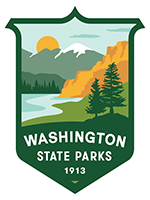Search results
1204 results found
OLYMPIA – Sept. 13, 2022 – The Washington State Parks and Recreation Commission will hold its regular hybrid commission meeting on Thursday, Sept. 22 at the Gladish Community Center in Pullman.
Commission action items include approval of the submittal of the 2023 supplemental operating and capital budget requests to the Office of Financial Management (OFM) and approval of the 2023 regular commission meeting schedule.
In addition, the commission will hear updates and reports from agency staff.
Curlew Lake State Park is perched in a high valley in northeastern Washington that owes its landform features to Ice Age glaciers. The lake, six miles long, half a mile wide, and reaching a depth of 130 feet, is centered in the valley of Curlew Creek. The creek drains to the Kettle River, which wanders back and forth across the US/Canada border to its confluence with the Columbia River near Kettle Falls.
Yakima Sportsman State Park owes its preservation and its distinctive name to the generosity of a group of waterfowl hunting enthusiasts who purchased lands in the Yakima River floodplain in the 1940s.
Folds, Floods, Meanders and Mines
The park is situated in a geographic area called the Yakima Fold Belt, an area of central Washington where tectonic compression of the layered Columbia River Basalt lava flows results in a series of parallel ridges that run perpendicular to the force of the stress—kind of like kicking a rug creates ridges in the fabric.
Cape Disappointment State Park spreads over the land north of the point where the Columbia River and the Pacific Ocean meet. The park includes three headlands of basalt rock cliffs: Cape Disappointment overlooking the river, North Head above the strand of Long Beach, and McKenzie Head, midway between the other two headlands. The basalt bedrock of these wave-pounded cliffs are ancient lava flows that erupted on the ocean floor. Encountering the cold ocean water, the lava quickly hardened into bulbous masses geologists call pillow lava.
OLYMPIA – Aug. 31, 2022 – Washington State Parks will close the lower parking lot and all restroom facilities at Tolmie State Park near Lacey on Tuesday, Sept. 6 to complete a fish passage project.
The upper lot at Tolmie will remain open, with space for 30 cars, and portable toilets will be available during construction. The work is set to start in September and wrap up in February of 2023. Visitors will be able to reach the beach on a steep trail from the upper parking lot.
Nationwide recruitment efforts lead to internal talent
OLYMPIA – March 16, 2022 – The Washington State Parks and Recreation Commission announced today the appointment of Diana Dupuis as the agency's new director. Dupuis will be the first female director since the agency was established more than 100 years ago.
The Washington State Parks and Recreation Commission (Parks) invites the public to participate in conversations about a potential expansion of Riverside State Park.
SPOKANE – The Washington State Parks and Recreation Commission (Parks) invites the public to provide feedback and participate in conversations about a potential expansion of Riverside State Park to incorporate a property, newly acquired by Inland Northwest Land Conservancy, and known as “Glen Tana.”
Clark Island Marine State Park preserves an entire long, narrow island along the northern edge of the San Juan Archipelago.
A Rocky Island
The San Juan Islands are distinct from most of Puget Sound in that they feature shorelines with exposures of hard bedrock, rather than the bluffs of clay, sand and gravel left by Ice Age glaciers that are predominant on most of Washington’s Salish Sea, the state’s inland saltwater passages.
Flaming Geyser State Park straddles the Green River at the lower end of the Green River Gorge, a unique place where sandstone bedrock, covered by glacial deposits in most of the Puget Sound lowlands, is revealed by the downcutting of the river through the formation. Seams of coal interwoven with the sandstone fueled a mining industry in the local area. On October 4, 1911, coal miner Eugene Lawson drilled a test bore in today’s park area, attempting to locate a coal seam. At 390 feet deep, he found a seam 6.5 feet thick.
Lyons Ferry State Park occupies a place at the drowned confluence of the Palouse and Snake Rivers, where people have crossed over the rivers for millennia.
Ice Age Floods Carve a Canyon
The walls of the Snake and Palouse River Canyons, and the cliffs which soar over the park are made of basalt lava flows that erupted from vents in southeast Washington. The forces of plate tectonics continue to shape this landscape, wrenching and stressing the vast layered basalt flows that make up Washington’s Columbia Plateau, weakening the rock along subtle fractures.
